Whenever a toilet is flushed in Geelong, the contents head south of the city to a locality known as Black Rock, located on the shores of Bass Strait midway between the towns of Torquay and Barwon Heads. So what happens to all the turds and toilet paper?
Some history
In 1906 the first moves were made towards sewering Geelong when the Geelong Waterworks and Sewerage Trust was established. It was decided to build an ocean outfall to dispose of the waste, as it was simpler to construct and cheaper to operate, with a site south of Geelong being selected due to the favourable ocean currents.
The site was known as ‘Black Rock’ due to the basalt rocks that lined the shoreline. Work started in 1912 on the concrete sewer linking Geelong and Black Rock, with the first raw sewage being pumped into the ocean in 1917.
During the 1950s the population of Geelong took off, and so did the amount of raw sewage being pumped out into the sea, so moves were made to upgrade the sewerage system that served the city. The existing concrete sewer was corroding due to seawater backing up into the pipe, so a new sewer was laid parallel to the existing one, and a rudimentary treatment facility was opened at Black Rock in 1968.
Three comminutors ground up the solid waste into smaller pieces, which was then allowed to flow via gravity into the sea at low tide. At high tide a penstock prevented sea water from entering the plant, with archimedes screws being used to pump the waste into the sea.

Barwon Water photo from ‘Living By Water: a History of Barwon Water and its Predecessors’
Concern about the environment started to grow during the 1970s, with beaches near the Black Rock outfall had become popular with surfers, resulting in public protests about the raw sewage being sent out to sea.
In addition, the establishment of the Environment Protection Authority in 1972 to regulate waste disposal made things difficult for the water board, which resulted in an ultimatum – build a sewage treatment plant and underwater ocean outfall. Planning work commenced in 1983, and the upgraded facility finally opened in 1989.
The new ocean outfall was 1.2 kilometres long and 1.35 metres in diameter, with the steel pipeline being constructed on land and then dragged out to sea over a 48 hour period.

Barwon Water photo from ‘Living By Water: a History of Barwon Water and its Predecessors’
As for the treatment plant, raw sewage was lifted up from the sewer by archimedes screws.

Barwon Water photo from ‘Living By Water: a History of Barwon Water and its Predecessors’
And then passed through filter screens to eliminate any particles larger than one millimetre in size.

Barwon Water photo from ‘Living By Water: a History of Barwon Water and its Predecessors’
Despite the addition of the screening plant, the effluent being discharged at Black Rock would not meet future EPA requirements, so in 1994 work started on a biological treatment stage using the ‘Intermittently Decanted Extended Aeration‘ (IDEA) process.

Barwon Water photo from ‘Living By Water: a History of Barwon Water and its Predecessors’
Four aeration tanks were built, each 120 metres long by 60 metres wide, where microorganisms would digest the organic material in the aerated wastewater, eventually leaving class ‘C’ treated water that was suitable for irrigation purposes, and wet biosolids for disposal elsewhere.
Disposal of this wet sludge was the next problem for Barwon Water – with a water content of 85% it was initially stored at Black Rock, until they ran out of storage space in 2001, so as an interim solution the 140 tonnes of waste produced each day was trucked to the Western Treatment Plant in Werribee for drying.
Work was then started on a permanent facility at Black Rock to dry the biosolids and compress it into pellets of nutrient-rich fertiliser, which commenced operation in 2013.
With the solids now taken care of, the final step in closing the loop of sewage treatment was the treated water. Work started on the Black Rock Recycled Water Plant to produce class ‘A’ treated water, which has been supplied to residents of the new Armstrong Creek and Torquay North housing developments via a ‘purple pipe’ system since 2013.
Footnote
You can find the Black Rock treatment plant at the end of Blackrock Road in Connewarre.
Sidenote
My grandparents used to live near Black Rock, so the ‘poo farm’ was a landmark we drove past every time we paid a visit.
Every so often my grandfather would drive us out to poo farm, passing the wind turbine on Blackgate Road and parking the car at the end of the road. We could then walk west along the coast, passing the red and white concrete vent shaft of the original ocean outfall, and the round concrete turret that marks the replacement outfall.
During the 1990s there were also two additional structures on the coastline – the original 1960s comminutor plant, and a massive concrete chamber that allowed the raw sewage to be mixed before entering the sea. Presumably both have been demolished in the years since, as no trace of them can be found today.
My grandfather also happened to play golf with one of the facility managers, so in sometime in the mid-1990s he wrangled us a tour of the treatment plant itself. On the top floor they had a lookout pointed at the end of the ocean outfall, and a collection of items pulled out of the incoming sewage, but the highlight was seeing inside the massive screening filters – they looked like a gargantuan version of a clothes dryer.
Sources
- The 2005 book ‘Living By Water: a History of Barwon Water and its Predecessors’ by Leigh Edmonds provides a detailed history of the water and sewerage systems of Geelong – a PDF copy is on their website.
- Leighton Contractors installed the Black Rock ocean outfall in 1986 – they describe the process here.
- Barwon Water describe their biosolids drying plant and recycled water plant on their website.
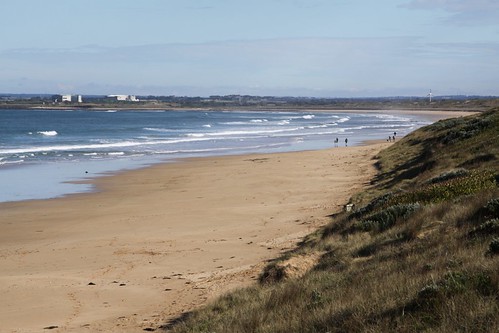

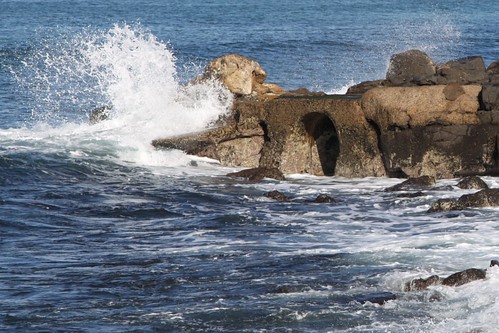
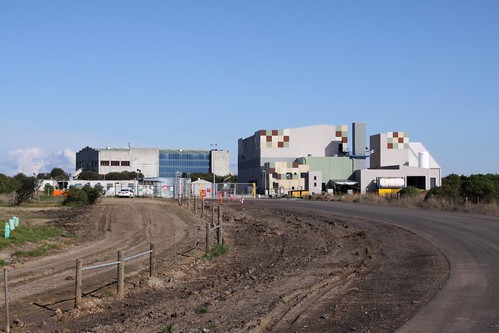
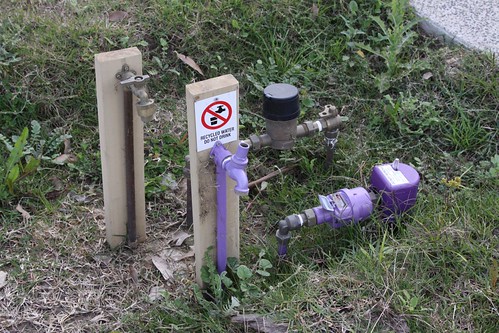

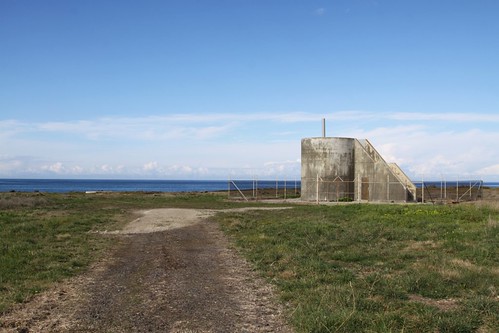

I’m the first comment? Disappointing. I’d hacve thought the comedians would be all over this one with their **ahem** crappy puns.
Flush with success?
There’s a ‘third pipe’ recycled water system in Victoria ? Great ! Didnt know there were any ! Though I suppose the Werribee plant supplying the market gardens should count.
My photo of the ‘purple pipe’ system is actually from the ‘Lakeside’ estate in Pakenham.
Unfortunately finding a complete listing of areas with third pipe systems is difficult – it is broken down by water retailer.
http://southeastwater.com.au/SiteCollectionImages/LearnAboutWater/TypesOfWater/OurWaterSupplyNetwork.jpg
http://www.yvw.com.au/Home/Waterandsewerage/recycledwater/Residents/Wherewillitbeavailable/index.htm
http://www.citywestwater.com.au/our_assets/west_werribee.aspx
With the Geelong region having systems to new housing estates at Armstrong Creek and Torquay:
https://www.barwonwater.vic.gov.au/residential/recycled-water
Most interesting and very surprising that proper treatment was not so long ago.
As part of one of the water civil engineering electives at Monash we had an excursion to the smaller treatment plant at Warragul, located on the eastern side of town. Toured the primary treatment stage (screening for solids such as cotton buds and plastics followed by sedimentation of larger particles) Then followed the secondary treatment stage (aeration tank/activated sludge followed by clarifier). Tertiary treatment would be UV disinfection before discharge – something not done previously.
The devices installed at the Black Rock sewer outfall in the 1960s to chop up any remaining solids in the sewage were called “comminutors”. Commutators are part of an electric motor.
I should know the difference, so it serves me right for putting blind faith in my spellchecker. 🙂
I lived in Breamlea from 1979 to 1990 and frequently wandered along the coast from Bancoora, up over the sand dunes, along the coast a bit more to 13th Beach and back. The communitor and vent shaft (either/both) emitted a strong stench and this was so offputting as to urge one to turn back once over the sand dunes walking east from Bancoora. During the mid-1980s construction of the treatment plant brought in huge numbers of machinery, noise, dust and stink. Friends living near us in Breamlea complained bitterly of ear and nose infections from surfing at and near Black Rock, despite the fact the location has never been all that favourable for surfing (or swimming!). It is very favourable for photography though in the right conditions.
Examples of the “purple taps” serving up “Chateau Wee” (motto: “fresh daily!”) can be found abundantly along the roadside on Horseshoe Bend Road and around Charlemont Estate. I don’t think everybody living on those estates is clued up on just where their tap water is coming from. Don’t tell anybody!! 😉
[…] The path between the stables and the racetrack is located atop Geelong’s main outfall sewer. […]
The above link to the Barwon Water PDF is no longer valid. I have tracked down a working link.
https://www.barwonwater.vic.gov.au/__data/assets/pdf_file/0022/6259/Living-By-Water_-a-history-of-Barwon-Water-and-its-predecessors.pdf
Great site by the way! Keep up the good work!
Glad you like my work – and thanks for the updated link.